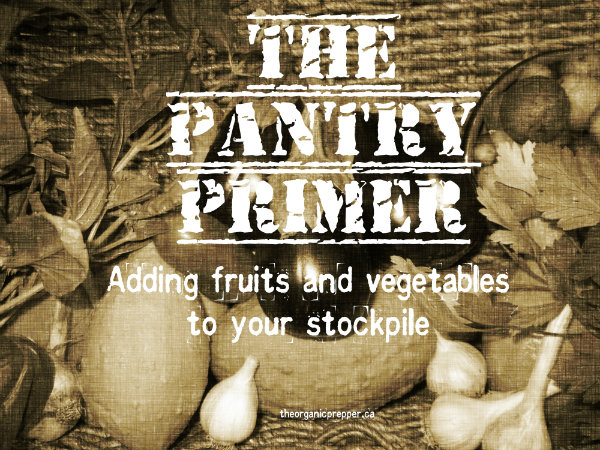If you're new here, you may want to subscribe to my RSS feed. Thanks for visiting!
A major challenge when living from your stockpiled foods is getting enough fruits and vegetables. Without produce, your family can be at risk for nutritional deficiency diseases like scurvy and their immune systems will be compromised. A minimum of 5 servings per day is recommended, but during the long winter, how can you meet that goal with the contents of your pantry?
Supplying your family with produce that will provide the necessary nutrients that their bodies need to thrive is a twofold process. Not only should you preserve the summer’s bounty for the winter ahead, but you should also come up with ways to add fresh greens outside of the growing season.
Building a Produce Stockpile
When creating your produce stockpile, you have to look at what actually constitutes a “serving” for the people you will be feeding. It may not actually be the amount that you expect. For example, a child’s serving of green beans is anywhere between a quarter cup to a half a cup (depending on their age), but an adult’s serving is a full cup. So for a child, plan on 1-3 cups of produce per day and for an adult, plan on 5 cups of produce per day.
Whenever possible, focus on organic produce. The use of pesticides in conventional farming is rampant. Even the hijacked Environmental Protection Agency has to admit that the ingestion of pesticides can cause health problems. They warn of the risk of “birth defects, nerve damage, cancer, and other effects that might occur over a long period of time.” (Keep in mind, however, that despite this warning, the EPA just RAISED the acceptable limit of glyphosate at the behest of Monsanto.) Especially at risk of harm from pesticides are prepubescent children and fetuses.
It’s also important to avoid GMOs (genetically modified organisms). Particularly avoid anything non-organic that contains corn or soy ingredients. (Learn more about why GMOs are not even safe in moderation.)
What to shop for
At the grocery store, look for sales to build your supply of produce:
Dried: Dried fruits such as raisins, banana chips (without sugar), and dried cranberries can pack a lot of nutritional punch into a tiny serving size. Think of them as concentrated vitamins. An adult serving of raisins is only 1/4 cup, which means that you can pack a lot of nutrition into a small amount of space with dried fruits.
Canned: Canned goods such as tomatoes, green beans, and peas can go a long way towards providing nutrition. The benefit to those rows of tin cans is that you don’t require power to store them safely, and they are fully cooked so you don’t even have to heat them up in a grid down situation. You can also find many varieties of canned fruit but beware of heavy syrups, which are often made with GMO corn syrup.
Frozen: Frozen fruits and vegetables are the closest to fresh that you can get. This is a great way to build a stockpile for good times, but don’t put all of your produce in the freezer. During an extended power outage, you stand to lose a large portion of your deep freeze contents. If you do purchase a large amount of produce for the freezer, have canning jars, lids, and an off grid method for canning them if the electricity goes down for the long-term.
Freeze dried: This is a more expensive option, but freeze dried fruits and vegetables maintain nutrients, require little storage space, and need no special storage conditions. You can add a great deal of variety to your pantry with a selection of freeze dried ingredients and the foods, if sealed correctly, can last up to 25 years. Learn more about freeze-dried foods HERE.
Preserving fruits and veggies
There are many effective ways to preserve fruits and vegetables that you acquire fresh. Whether you harvest them from your own property, buy them at the farmer’s market or a local orchard, or even make a bulk purchase from the discount bin at the grocery store, having the supplies and skills to quickly preserve them can allow you to make the most of your windfall. Learn more about the following methods.
- Dehydrating
- Canning
- Root Cellaring
Any tips?
Many in our community are just beginning to build their pantries. Do you have any budget-friendly tips for adding fruits and vegetables to the larder? Please share them in the comments below…
Want to learn more? My new book is now available!
Lots of us like to have hard copies of information that we’ve found helpful. Because of this, I’ve expanded on the information included in this series and put it all in one handy primer, available on Amazon.
The Pantry Primer: How to Build a Whole Food Pantry on a Half Price Budget

















8 Responses
http://tcpermaculture.blogspot.ca/2013/02/free-e-book-introduction-to.html
Come on…seriously? Get thee to an intro to permaculture course.
7 things any idiot can grow:
potatoes in a box with mulch hay and no soil
kale
garlic
swiss chard
chives
onions
squash
Windowfarms! You can buy a kit, or just download free instructions. DIY recycled/repurposed. Herbs grow nicely in them, strawberries have been successful, cut and come again lettuces, tumbling cherry tomatoes. No tubers, though, the method isn’t suitable.
Tuber crops are easy and yield and store well. Also Vit C.
People should have a garden area designated for tubers only. In those you have Jerusalem Artichoke and a variety of potatoes (reds, yellows, russet).
In a small area a person can have food around August and then harvest the rest around late September and have a food source for 3-4 months.
Daisy:
I love this Pantry series. Thank you SO much for all you do for us!
I have lettuce and spinach growing now in a gutter on my porch. I also put in small winter garden of kale, swiss chard, beets and carrots. In my area, we don’t get a multiday hard freeze until after Thanksgiving.
I will be sharing your site with my friends. You have such great information.
This summer I am going to make a gutter garden from left over rain gutters for my daughter. ( which means myself also). Mostly seasoning tho I think as we have a few ares to use as a farm..
Jack,
P.S. I really like this cite.
I buy “red” (fruit) and “green” (vegetable) powdered drink cannisters from health food store or Amazon. One tablespoon of each is a full day’s serving of fruit and vegetables. No spoilage, stores for years, cheap per serving cost.